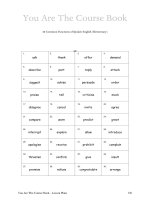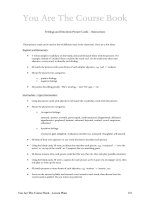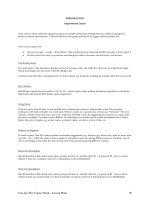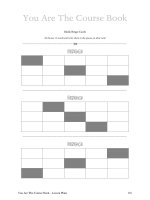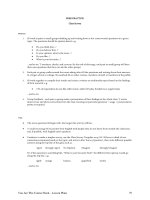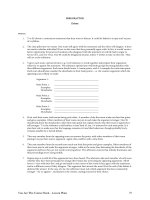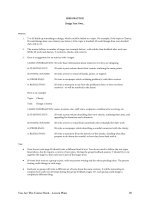yatcb lesson plans discussion words standard lesson
Bạn đang xem bản rút gọn của tài liệu. Xem và tải ngay bản đầy đủ của tài liệu tại đây (58.38 KB, 3 trang )
VOCABULARY
Discussion Words – Standard Lesson
1 set of word cards per small group
Materials:
Preparation:
T prepares the target vocabulary words – one set for each small group. Each word should be on an individual small
piece of card or paper. The vocabulary could be:
•
•
•
words suggested by SS – as in Mode 1
keywords from a text – as in Mode 2
words from a particular vocabulary set – as in Mode 3 1
Method:
1.
T gives out a set of cards to each group and asks them to put all the cards out on the table so that
everybody can see them all. Then SS put them into two groups – words they know and words they don’t
know.
2.
T asks SS to shout out words they don’t know. Other SS in other groups help by giving definitions or
translations. T reminds SS to use dictionaries and write down the new words.
3.
T asks SS to put the words into alphabetical order. This helps them to remember words they have just
learned, because they are focusing on them again. T asks SS from different groups to read out part of their
list. T writes incorrectly pronounced words on the board and draws SS’s attention to them. T drills the
words with the SS from A-Z. T says each word once, then the whole group repeats it.
4.
T describes a word and one person from each group has to run to the board and write it. The SS who is the
quickest (with correct spelling) wins points for their group.
5.
T asks SS to turn over the cards so that they are blank side up. SS work in groups. Each SS takes 4-5 cards
and keeps them secret. They take it in turns to describe one of their words for the others in their group to
guess. If somebody guesses right, that person can keep the card. The SS with the most cards at the end of
the game is the winner.
6.
T elicits the meaning of ‘syllable’. T asks SS to put the words into groups according to how many syllables
they have. T checks each group’s progress. T asks each group for feedback and corrects errors.
7.
If not already known, T outlines the basic concepts of word stress:
•
•
•
•
•
•
8.
Stress is important in English
Each word or phrase has one strong stress
When listening we recognise a word by the stressed vowel sound
The stressed syllable is usually the nearest strong syllable to the end (see p.113)
Suffixes are not usually stressed
Compound nouns are stressed on the first syllable
SS put the words into groups according to stressed syllable, then practise saying them out loud. (Words
with one syllable are discarded, because the stress is on the whole word.)
1 For 42 vocabulary sets organised by topic see: Purland, Matt. You Are The Course Book 2: In Practice. Ostróda: English Banana.com, 2013.
Hardback. Available for free download: p.434
You Are The Course Book – Lesson Plans
27
9.
How many words can each group remember when all the cards are turned over?
•
SS love this activity and you could easily let them spend 90 minutes or longer playing with the vocabulary
cards. There is so much to do and they enjoy this unusual method. However, do not let it go on for the
whole lesson. Try to include balance and work with other skill areas, e.g. grammar, tenses, and free
practice too.
Tip:
Extension Activities:
•
Having identified each stressed syllable (point 8), SS write down the stressed vowel sound in each
word or phrase using Clear Alphabet.
•
SS think of ten, twenty, thirty or forty additional words on the same topic, e.g. Music, and make
their own discussion words cards, using the blank templates (from p.108).
•
SS create their own comprehension questions (see p.49), then swap them with another group.
Then check that group’s answers.
•
SS put the words into any of the following groups, then order them:
o
o
o
o
o
o
o
o
o
o
Words that have the same stressed vowel sound
Groups which relate to the topic, e.g. musical instruments in Music topic
Words that have suffixes or are compound nouns
Words that start or end with a vowel sound or letter
Words that start or end with a consonant sound or letter
Words that are the same word type, e.g. verbs, nouns, adjectives, etc.
Different kinds of nouns: countable, uncountable, proper, abstract, etc.
Words that are negative or positive
Words that have the same number of letters
And so on...
•
‘Yes/no’ questions: one SS takes a card with a word on it, keeping it secret from the others, who
have to ask ‘yes/no’ questions in order to find out what it is. The first SS can only answer “Yes”
or “No”.
•
Word association activities:
a) T (or SS) chooses a word and each SS has to say six words that they associate with this word.
Or each SS in the group has to say one word. For example, if the word is ‘head’ the SS could say
‘nose’, ‘face’, ‘eye’, ‘ear’, ‘chin’, ‘mouth’, and so on.
b) T (or SS) chooses a word and the first SS says the first word that comes into their head,
followed by the next and the next in a kind of word association chain. See how long your group
can go for without running out of steam. You may be surprised where you end up! For example:
‘dog’ > ‘bark’ > ‘tree’ > ‘field’ > ‘farm’ > ‘cow’ > ‘milk’, and so on.
•
Improvisation: a SS is given a word (or chooses one) and has to talk about it for a set period, e.g.
twenty seconds. If they pause for longer than, say, five seconds, the word passes to the next SS, or
a new word is given. For higher-level groups you could lengthen the period of time, e.g. to one
minute. You could give points to each SS for the length of time that they manage to talk without
a long pause, and add them together to get a winner at the end of the game. For example, if the
SS talks for fifteen seconds, you would give them fifteen points, and so on.
You Are The Course Book – Lesson Plans
28
•
2
Play vocabulary battleships! SS have to work in pairs and they both have a copy of the discussion
words page from that lesson’s topic, e.g. Sport 2. They should label the columns at the top A, B, C,
and D, and the rows on the left-hand side from top to bottom 1-10, so that the word ‘volleyball’
could be in cell B5, for example. Each SS marks ten (or more, or fewer) random cells in their grid
– these are their ‘battleships’. Without showing their page, Student A asks for a cell on Student B’s
grid. For example, “Can I have D5, please?” If this cell (‘cue’) has not been marked as a battleship,
Student B says, “Miss!” and play passes to them. Student B now requests a cell on Student A’s
grid, e.g. “I would like A6, please”, which is ‘swimming’. If ‘swimming’ has been marked as a
battleship, Student A must speak in English for at least twenty seconds about that word – without
pausing! If they can do it, play passes back to them. If they can’t do it, Student A’s battleship is
‘sunk’ (and crossed out on both grids) and Student B can choose another cell on the grid. The
object of the game is to ‘sink’ all of your partner’s battleships by: a) guessing the correct grid
reference, and b) speaking for twenty seconds (or longer) about the vocabulary words, without
pausing. This is a great game to get SS speaking in English, as well as to encourage creativity and
lateral thinking.
See You Are The Course Book 2: In Practice, p.471
You Are The Course Book – Lesson Plans
29
